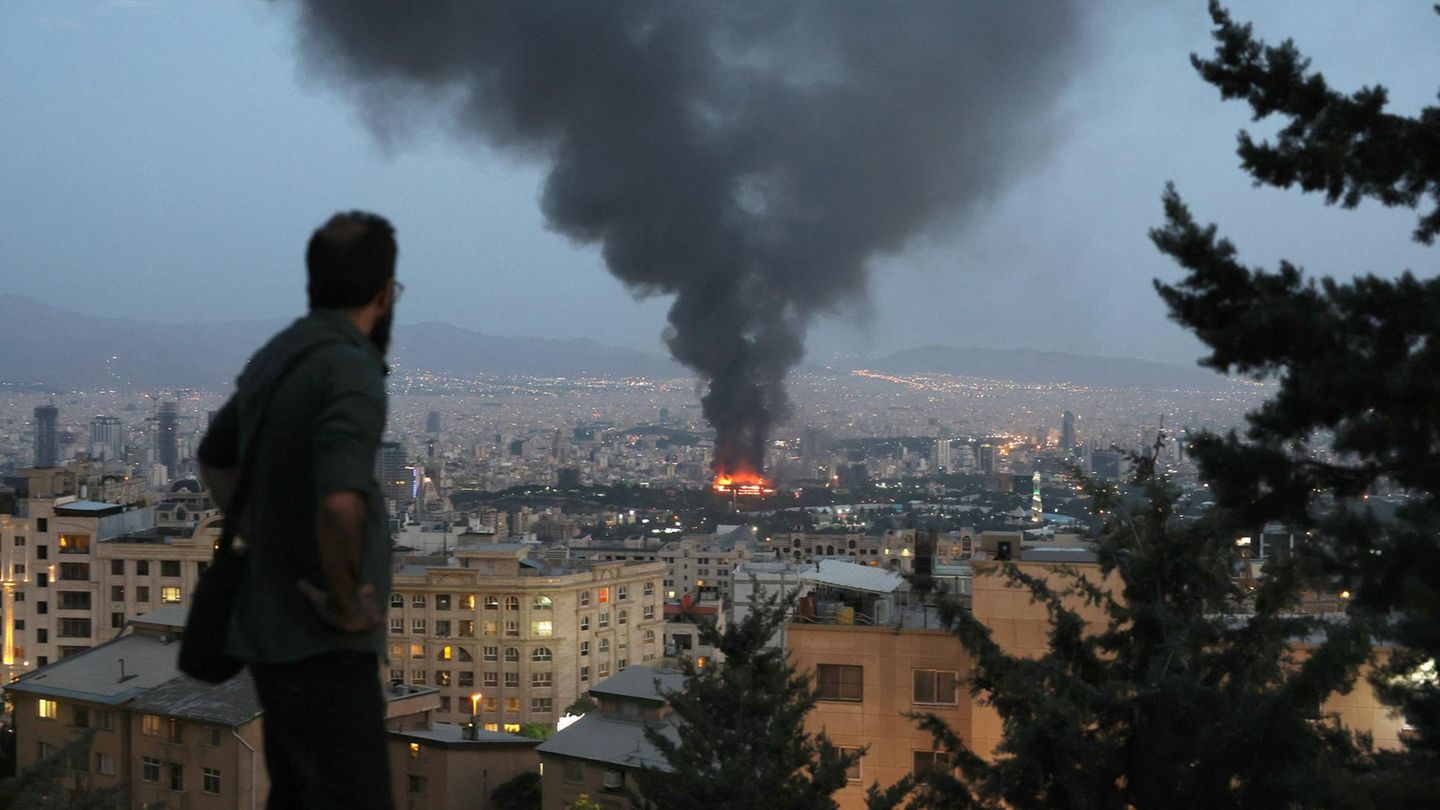Panic in Tehran, Iron Dome overwhelmed
That is the situation on day five of the war
Copy the current link
Add to the memorial list
Israel has attacked Iran since Friday, which strikes back. The events roll over. This overview brings you to the last stand – everything you need to know.
The great war in the Middle East is there – Israel flew to Iran on the night of June 13th. The goals: bases of the revolutionary guards, aircraft systems-and: the Iranian nuclear program. The events have been overturning since then. Counter attacks followed attacks, rocket strikes on drone attacks. Cities like the Iranian capital Tehran or the Israeli Tel Aviv are always destinations.
But what exactly has happened in the past few days? That is the current state of the situation:
What are the goals of Israel’s attacks?
The Israeli military’s first wave of attack on June 13th primarily aimed at high -ranking military staff and the nuclear program of Iran. According to the “Rising Lion” operation, Israel targeted at least six military bases around Tehran as well as residential buildings for military commanders and several residential buildings around the capital. Just like the nuclear facilities of Natan and Fordo, the system for uranium preparation in Isfahan and the nuclear research center in Tehran. At least 20 high -ranking military, as well as several physicists who are said to have been involved in the nuclear program, were killed.
How difficult was the Iranian nuclear program hit?
Israel justifies his attack by the fact that Iran was immediately before the production of nuclear weapons. This allegation cannot be checked independently. If it is true: has Israel achieved his goal? Could the nuclear program be destroyed?
So far, this is unclear. The only independent source of the damage to the facilities is the International Atomic Energy Agency (IAEA). Partially contradict the Israeli information or mitigate them. One thing is certain: the largest nuclear system of Iran, Natan, was hit and damaged. Israel reported the destruction of important facilities, including an underground complex with centrifuges. Iran speaks of “mostly superficial damage”, the IAEA only confirms damage to the system.
The situation around the second facility in Fordo is even more confusing. Israel reported attacks on the complex, several media confirmed explosions nearby, but according to IAEA it was not damaged. Iran also said that there was “no structural damage”.
According to Israel, the Isfahan complex in Centraliran was completely destroyed that laboratories were also damaged. In this case, the IAEA did not comment independently, only quoted the Iranian authorities, according to which a hit was confirmed.
The nuclear research center in Tehran was named or damaged by Israel as an attack goal, but not met or damaged according to previous knowledge.
At this point, our editorial team has integrated content from Datawrapper GmbH.
Due to their data protection settings, this content was not invited to protect their privacy.
You can see on these cards which goals have so far been attacked, where Iran’s nuclear facilities are located and which retaliatory strikes have been accepted so far:
It is therefore not independent to say how difficult the infrastructural damage to the Iranian nuclear program is. Due to the attacks, Israel is likely to have met and thrown back research and production of nuclear weapons capable of nuclear weapons. Not only through the damage to the systems, but also by killing several leading scientists in the program.
How strong is the Iranian military?
According to the International Institute for Strategic Studies (IISS), Iran has one of the number of armed forces in the Middle East. Over 600,000 active soldiers and another 300,000 reservists are therefore available. The revolutionary guards have their own air, soil and naval forces.
Technologically, however, the Iranian military is largely outdated. Many of the fighter jets used date from the 1970s and 1980s. The strength of Iran is therefore less in its conventional forces. His chance would be: rockets, drones, cyber attacks, attack by deputy militias such as the Huthis and the blockade, for example from oil transports. Because the previous battles show that Iran seems to be inferior to a technologically superior opponent like Israel.
Why couldn’t Israel’s protective sign Iron Dome intercepted numerous retribution strokes?
Despite the Israeli Iron dome system, dozens of Iranian rockets and drones achieved their goal. The reason: Even if the technology of the intercuping system is sophisticated, it only has attacks up to a certain point, as military expert Guido Schmidtke explains: “At some point the sheer crowd even the most modern air defense. Some of the flying missiles can no longer be intercepted. In this case, the Iranians can certainly hit goals in Israel and destroy these goals.” The Iron Dome prevented worse – but there were deaths, fires and considerable damage in Israeli cities. Tel Aviv and Haifa in particular were hit by the rockets.
What are the effects of Israeli attacks on the Iranian civilian population?
In Tehran, air raids leave destroyed houses, crowded hospitals and damaged supply lines. Many medical facilities are at the limit, thousands of injuries were waiting for treatment, according to Witnesses to the British “”. Even before the attack, the supply was unstable, water was partly for days.
Logistics chains are disturbed across the country, refineries are damaged, the gasoline supply has almost collapsed. Iranians are allowed to recharge with a maximum of 25 liters, so “”. Money withdrawals were also limited. The military claim the majority of the supplies.
After the attacks, a mass escape from Tehran used, as “” reports. The city has hardly any protective bunkers, the residents only have the metro as a refuge. Many residents are towards Mazandaran north of Tehran – by car, motorcycle or on foot. There are no more scenes like since the Iran Irak War in the 1980s.
What are the consequences of the conflict so far globally?
The Israeli attack came as a surprise to most experts, since land is also in the war or at least in battles with the Hisbollah, Hamas and Huthis. The global effects are still manageable. There has been no surface burn in the Middle East, share prices need temporarily, the oil price rose – but the consequences for the global economy are still manageable.
But that’s just a snapshot. The attack of Israel could even bring Iran closer to the bomb – because the regime in Tehran could conclude: an atomic bomb alone scares Israel or the USA alone.
The second major threat to the world: the blockade of the Hormus street. The sharpest sword of the Mullahs is not her military, her revolutionary guards. It is the oil price. On the first day of the attack, the guiding price skims by twelve percent. In the meantime, the price has normalized again. But that doesn’t have to stay that way.
If Iran blocked the street of Hormus, a sea between Iran and the Oman, this would be a shock for the global economy. The oil from Kuwait, Bahrain, Qatar, Iraq, Saudi Arabia and also from Iran itself, must pass this 40-kilometer wide waterway by ship-about a third of the global oil deliveries would be cut. The effects could hardly be estimated.
Source: Stern
I have been working in the news industry for over 6 years, first as a reporter and now as an editor. I have covered politics extensively, and my work has appeared in major newspapers and online news outlets around the world. In addition to my writing, I also contribute regularly to 24 Hours World.





